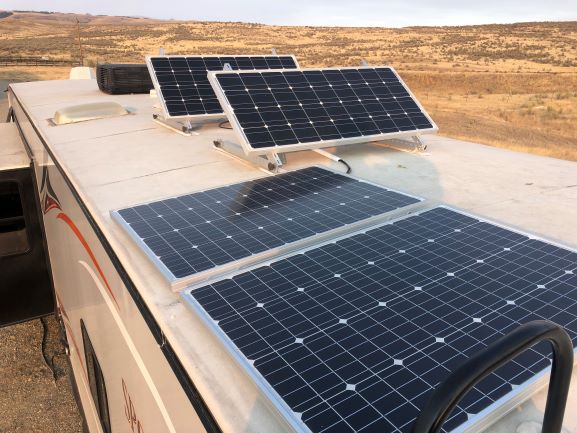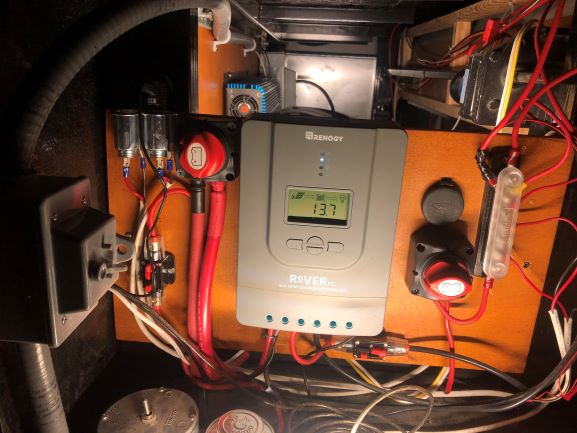Solar – Where to start?

We felt right from the start that we wanted to live more off-grid than anything else. So far that has not been as much as we would like. Although while we travel from destination to destination the capability of being pretty self sufficient is comforting.
Energy management is very key to living this lifestyle. With a good understanding of your electrical needs is a primary goal. For instance knowing that the refrigerator draws 11 amps at 12 volts of electricity converts to roughly 132 watts. This can be figured out by either looking up a Watt/Volts/Amps conversion calculator or just using a Watts (P) to Amps (A) formula.
DC watts to amps calculation formula
The current I in amps (A) is equal to the power P in watts (W), divided by the voltage in volts (V). Formally it reads as this:
I=P/V
Simply amps are equal to watts divided by volts.
amps=watts/volts
or
A=W/V
Or
W=AxV
132=11×12
So now you ask what does this information have to do with solar? Right? Well, simply put, it has everything to with it. If you want to know what size batteries to get to last a certain length of time you will need this information. Back to the refrigerator using 132 watts or 11 amps. Those 11 amps will last about 9 hours on a 100 amp hour (AH) battery and less depending on the type of battery you use. Some batteries are best if only used to 50% DOD (Depth Of Discharge) so right off the bat your down to 4.5 hours of total run time. NOTE: refrigerators do not run continuously so it can be deceiving.
Another example would be an electric ceramic heater. The one I am using right now as I write this is a 250 watt heater at 120 volts. So back to the formula we will use the formula of:
A=250/120
A=2.08
This shows the current FROM the inverter
Or
A=250/12
A=20.8
This shows the current TO the inverter
Conclusions
As you can see by the calculations above, understanding voltage, amperage and wattage is a very important factor in calculating one solar needs. This information not only helps size batteries but also wire size, inverter sizing, solar array sizing and total needs of your system. Also while figuring this out be sure to think of expansion if necessary. We use Renogy for our panels and controllers. Very helpful and informative. We will get into that on the next step in the journey of building a solar off-grid system.
Helpful information
If you cannot find what you need by reading labels on your appliances then there is a quick spreadsheet that will give you average information for most common appliances using 120 volts:
| Appliance | Load Range (Watts) | Average Load (Watts) | Amps |
| Air Conditioner (each) | 1400-2000 | 1700 | 14.1 |
| Battery Charger | Up to 2,000 | 1000 | 8.3 |
| DC Convertor | 300-1200 | 750 | 6.2 |
| Refrigerator | 600-1000 | 800 | 6.6 |
| Microwave Oven | 1000-1500 | 1250 | 10.4 |
| Electric Frying Pan/Wok | 1000-1500 | 1250 | 10.4 |
| Electric Stove Element | 530-1500 | 675 | 5.6 |
| Electric Water Heater (6 gallon) | 1000-1500 | 1250 | 10.4 |
| Electric Iron | 500-1200 | 850 | 7.1 |
| Hair Dryer | 500-1500 | 1000 | 8.3 |
| Electric Coffee Pot | 550-750 | 650 | 5.4 |
| Television (CRT) | 200-600 | 400 | 3.3 |
| Radio | 50-200 | 125 | 1.0 |
| Electric Drill | 250-750 | 500 | 4.2 |
| Electric Broom | 200-500 | 350 | 2.9 |
| Electric Blanket | 50-200 | 125 | 1.0 |
| Portable Heater (Ceramic) | 1500-750 | 1500 | 12.5 |
| Toaster | 1200 | 1200 | 10.0 |
| Food Processor | 720 | 720 | 6.0 |
| Hand Vacuum | 240 | 240 | 2.0 |
| Crock Pot | 230 | 230 | 1.9 |
| Satellite Dish and Receiver | 200 | 200 | 1.7 |
| Heating Pad | 60 | 60 | 0.5 |

Disclaimer: Some links are affiliate links and by clicking them help support another Damm Fine Adventure.
We are Amazon Associates and we earn from qualifying purchases.
